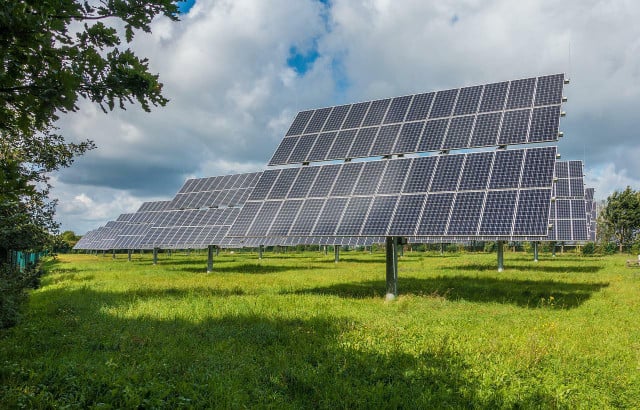Solar windows are an emerging technology based on the principle of turning sunlight into electricity. We'll discuss the history and recent developments of this technology.
Solar windows get their name from their unique ability to absorb solar energy and turn it into electricity. Solar energy is a type of renewable energy because it comes from a source that will never run out (at least for the next 5 billion years). This makes it an important supplier of sustainable energy that can be harvested in a number of ways.
One of these ways is through windows. This is done through the use of solar cells, which are sandwiched between two panes of glass that make up the solar windows. Since the solar cells are transparent, they allow light inside while still absorbing energy.
How Solar Windows Work

(Foto: CC0 / Pixabay / mrganso)
Solar cells are made from semi-conductive materials, such as silicon, which allows them to act as both a conductor and insulator of energy. This affects the way energy moves through them.
In basic terms, the energy inside solar cells is made from two elements – electrons emitting a negative charge and holes emitting a positive charge, which sit in a grid-like structure inside the cell.
When light hits the solar cells, it stimulates the negatively charged electrons in the cell. This causes them to move out of the silicon structure, leaving a positively charged hole in its place. The positively and negatively charged particles repel each other.
This is important because it means that the electrons only move one way – away from the positively charged holes. As the electrons move away from the holes, they are captured by an external circuit. Here, their energy is converted into electrical power.
The Short History of Solar Windows



(Foto: CC0 / Pixabay / WikiImages)
The mechanism described above was first invented by the French physicist named Edmond Becquerel in 1893. He coined the ‘photovoltaic effect’ to describe when solar energy was converted into electrical energy. The effect was later used to create the first solar cells in 1984 during an experiment by American inventor Charles Fritts.
However, at the time, these solar cells had very low efficiency. The efficiency was less than 1 percent, making them impractical for actual application. Luckily, by 1941, prominent scientists at the bell labs in New Jersey had begun to address this issue, and by 1958, solar cells were powerful enough to be used as a generator for NASA satellites. This paved the way for further interest and development of solar cells, leading to the technology we currently use today.
While solar panels are commonly seen on fields or rooftops, solar windows face two challenges that inhibit their widespread use: they need to retain at least some transparency, plus they will likely only face the sun for a few hours each day.
While solar windows have been around since the 1980s, the industry is still striving to find the ideal material to use: most commercial solar windows nowadays are made from glass coated in amorphous silicon. If the coating is thin enough so that the window stays transparent, however, the efficiency is only at around 5 percent.
Do Solar Windows Really Work?



(Foto: CC0 / Pixabay / Victoria_Borodinova)
Silicon solar cells are currently the most commonly used technology on the market. According to the US Department of Energy (DoE), these solar cells have an average efficiency of 18-22 percent, with a maximum of just over 25 percent. However, when it comes to solar windows, this is often limited by the thickness and heat absorption of glass. A more accurate estimate for windows works out at about only 15 percent efficiency, even on sunny days.
This would be the same as 1509 WH per day. To put this into perspective, one solar window would power a 50-inch LCD television for roughly 6 hours. If the average house has 10 windows, we could expect about 60 hours of television time. But in reality, windows not facing the sun would be less efficient, and you would need sunny weather throughout the day. Nevertheless, many remain optimistic that solar windows could be the next step in revolutionizing solar technology.
Recent Developments in Solar Window Technology



(Foto: CC0 / Pixabay / jarmoluk)
Recently, researchers have advanced the idea of using semi-transparent polymers or perovskites to replace the use of silicon in solar cells. Perovskite cells are a hybrid of inorganic and organic materials such as lead or tin compounds. According to the research results, the unique quality of perovskites can increase the effectiveness of solar cells by as much as 27 percent. The problem at present with implementing this technology, however, is threefold:
- Environmental Issues: Perovskite cells made of lead compounds have a toxic effect on the environment.
- Cost: Low-cost technology is needed to scale the solar cells without reducing performance.
- Stability: Organic materials are particularly at risk from oxygen, moisture, and other environmental factors. This means the long-term stability of perovskite and polymer cells is uncertain.
If these issues are addressed, researchers believe that solar windows could become more widely adopted. The DoE has been working with the National Renewable Energy Laboratory (NREL) on new solar windows that can adapt to temperature changes and make energy conversion more effective. In 2022, the NREL estimated this technology could be fully adopted by 2050.
Where to Get Solar Windows
In the meantime, several companies in the US have made their own solar windows available to the commercial and residential markets. Though most companies are still in the early phases of funding, there are a few already selling solar windows to the public:
- Solar Window Technology: This technology is a liquid or film coating that can be applied to windows. It allows them to generate the photovoltaic effect on windows that is collected by a generator to produce electrical energy.
- ClearVuePV: This is an integrated glass that is installed directly into a building. It uses nanotechnology to draw light energy to photovoltaic modules on the edge of the glass. This energy can then be converted into electrical energy.
- SolarGaps: These are solar panel blinds that can be installed over an existing window. The binds automatically adjust to the direction of incoming sunlight to capture light energy, which can be converted into electricity.
Eventually, it is likely to become more common to have solar windows in homes across the USA. All of these innovations open a promising window for the future of solar technology.
Read more:
- 7 Outdoor Solar Lights to Brighten Up Your Yard
- Conserving Energy: 10 Ways to Save Electricity
- How to Clean Solar Panels the Eco-Friendly Way
Do you like this post?








